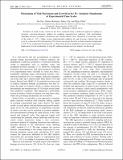Mechanism of Void Nucleation and Growth in bcc Fe: Atomistic Simulations Experimental Time Scales
Author(s)
Fan, Yue; Kushima, Akihiro; Yip, Sidney; Yildiz, Bilge
DownloadFan-2011-Mechanism of Void Nu.pdf (947.4Kb)
PUBLISHER_POLICY
Publisher Policy
Article is made available in accordance with the publisher's policy and may be subject to US copyright law. Please refer to the publisher's site for terms of use.
Terms of use
Metadata
Show full item recordAbstract
Evolution of small-vacancy clusters in bcc Fe is simulated using a multiscale approach coupling an atomistic activation-relaxation method for sampling transition-state pathways with environment-dependent reaction coordinate calculations and a kinetic Monte Carlo simulation to reach time scales on the order of ~10[superscript 4] s. Under vacancy-supersaturated condition, di- and trivacancy clusters form and grow by coalescence (Ostwald ripening). For cluster size greater than four we find a transition temperature of 150 °C for accelerated cluster growth, as observed in positron annihilation spectroscopy experiments. Implications for the mechanism of stage-IV radiation-damage-recovery kinetics are discussed.
Date issued
2011-03Department
Massachusetts Institute of Technology. Department of Nuclear Science and EngineeringJournal
Physical Review Letters
Publisher
American Physical Society
Citation
Fan, Yue et al. “Mechanism of Void Nucleation and Growth in Bcc Fe: Atomistic Simulations at Experimental Time Scales.” Physical Review Letters 106.12 (2011) © 2011 American Physical Society
Version: Final published version
ISSN
0031-9007